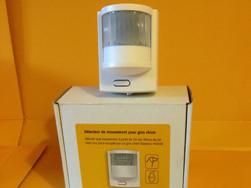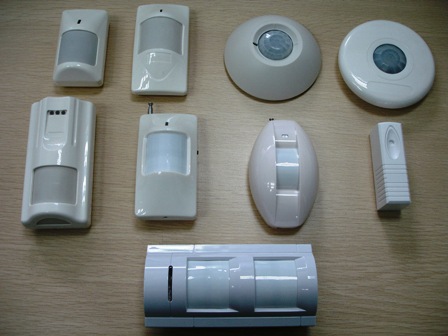Categories: Home automation, How does it work
Number of views: 97417
Comments on the article: 1
How infrared motion sensors are arranged and work
 Infrared motion sensor - This is an electronic device capable of responding to changes in the intensity of background thermal radiation in the zone of its action. Absolutely any objects possess thermal radiation, and not just a person.
Infrared motion sensor - This is an electronic device capable of responding to changes in the intensity of background thermal radiation in the zone of its action. Absolutely any objects possess thermal radiation, and not just a person.
If an object of sufficient size moves at a sufficient speed, crossing the working area of such a sensor, it will trigger, and the sensor will send a signal to the electronic control circuit to perform one or another action by one or another device. Such a device can be either a switch or a dimmer, or security alarmor anything else.
Obviously, such an infrared sensor can be used for various automation purposes, both at home, and in production and other enterprises and facilities. Fundamentally there are no restrictions on the field of application of infrared sensors.
The design of the infrared sensor is based on pyrodetectors, which are used to recognize infrared radiation, and a multi-lens, consisting of many small lenses. A multi-lens looks like a matte cylinder with a small pattern applied to its surface. Pyrodetectors are located inside the sensor housing behind the multi-lens.

Each small lens (each segment of a multi-lens) focuses infrared light on one of these receiving elements, which creates a configuration of focused beams, then when the object (infrared radiation source) moves, infrared light falls on another microlens, focusing on another pyrodetector.
It turns out that focused infrared light is supplied to the pyroelectric receiver, then it disappears. This provides a condition for triggering the electronic circuit of the sensor, an electrical signal is supplied to the processing unit, and one or another action is performed by one or another device.
It is clear that the more segments the multi-lens contains, the more sensitive the sensor will work, since each micro-lens works with its own segment, covering its own part of the working space, and when the object is moved inside this segment, the operation will not occur.

In the design of the infrared sensor, dual or even quadruple pyroelements are often used, this is done to more accurately trigger the device, eliminating minor light interference caused by a change in the background temperature. The four pyroelements (two twin) used in the latest models of infrared sensors completely eliminate false alarms.
When installing an infrared motion sensor, some important conditions must be observed. Firstly, direct light from the lamp should not fall on the sensor, it will interfere with proper operation. Secondly, there should not be any foreign objects in the sensor coverage area, such as: pendant lights, chandeliers, columns, high furniture elements, and other objects that limit the sensor’s view.
Glass partitions in the sensor coverage area will also interfere, since infrared light does not pass through the glass. If the interfering object nevertheless falls into the sensor’s coverage area, this is fraught with the appearance of the so-called “dead zone”, in which the movement cannot be detected simply because infrared light will not get onto the sensor’s lens.
The main characteristic of an infrared motion sensor is the detection radius of a walking person. The radius of movement must necessarily reach the corners of the room, and if this does not work out, you will have to install two or three of these sensors in the room.
Each sensor has its own circular detection diagram, and if one such diagram is not enough to cover the entire space, such as a room, several sensors will have to be installed so that their detection diagrams overlap with each other, this will ensure the quality of the mounted automation system as a whole.
Infrared motion sensors are different. The most common models respond to movement, but there are more functional models that expand the possibilities for automation.
For example, there are models that can monitor the illumination if a moving person is present in the work area. When there is enough light from the windows, such a sensor may turn off artificial light, and turn it on when it starts to get dark.
In such sensors, it is possible to configure such a sensitivity specifically to light. This is especially true for house entrances, when it is important to optimize energy consumption, including light only in the dark, or only when a person is walking up the entrance. Material costs due to such an automated system can be significantly reduced.
See also on this topic:Automatic lighting switches with infrared and acoustic sensors
See also at i.electricianexp.com
:

